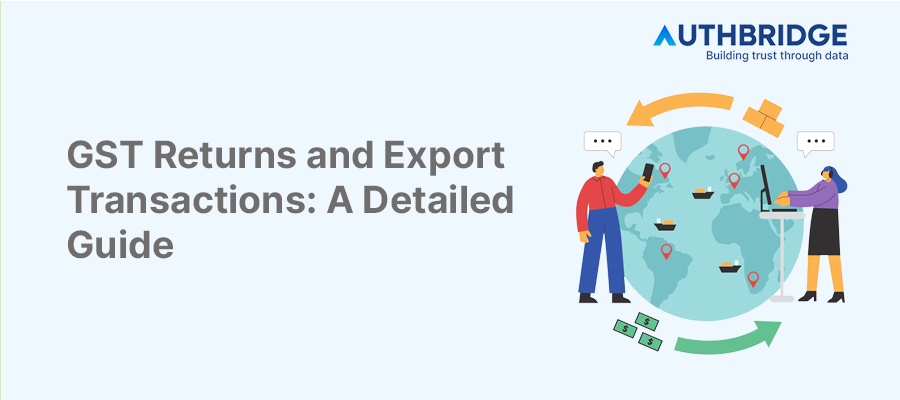Mastering GST Returns For Export Transactions

1. Introduction to GST on Exports
Definition of Zero-Rated Supply
Under the Goods and Services Tax (GST) regime, exports are treated as zero-rated supplies. This means that goods or services exported outside India are subject to a GST rate of 0%. The objective is to ensure that goods or services exported are not burdened with domestic taxes, making them more competitive in the international market.
Overview of Export Procedures under GST
The GST framework simplifies the export process by allowing exporters to conduct transactions either by paying the Integrated Goods and Services Tax (IGST) and claiming a refund later or by exporting without payment of IGST under a Letter of Undertaking (LUT) or bond. This flexibility ensures that the liquidity of exporters is not adversely affected due to the upfront payment of tax on exported goods or services.
2. GST Refund Process for Exports
Export with Payment of IGST
- Filing Requirements and Documentation: Exporters opting to pay IGST on exports must declare their export invoices in GSTR-1 under Table 6A – Exports Invoices. Essential details include the invoice date, port code, shipping bill number, invoice value, and the GST paid. It's crucial that these details match with the corresponding shipping bill filed with the Indian Customs Electronic Commerce Gateway (ICEGATE).
- Refund Claim Process: The shipping bill filed at ICEGATE serves as the refund application for the IGST paid on exported goods. The GST system automatically processes the refund based on the details furnished in GSTR-1 and credits it to the exporter's bank account. For services, a separate refund application in Form GST RFD-01 is required, to be filed on the GST portal.
Export without Payment of IGST
- Utilising Letter of Undertaking (LUT) or Bond: Exporters can export goods or services without paying IGST by furnishing an LUT or bond. This option allows them to export without tax payment and claim refunds on the input tax credit for taxes paid on inputs and input services used in exporting the goods or services.
- Refund of Unutilised Input Tax Credit (ITC): For exports made without payment of IGST, the refund process involves claiming the unutilised ITC. Exporters must file an application in Form GST RFD-01 on the GST portal, detailing the ITC to be refunded. The process requires the submission of relevant documents and is facilitated online for a smoother refund process.
3. Reporting Exports in GST Returns
Present System: GSTR-1 and GSTR-3B
In the current GST filing system, exporters must report their export transactions in GSTR-1 and GSTR-3B. GSTR-1 requires detailed invoice-wise information of exports, while GSTR-3B includes a summary of outward supplies, including zero-rated supplies. The information reported in GSTR-1 is used for processing refunds of IGST paid on exports.
New GST Return System: ANX-1 and RET-1
Under the proposed new GST return system, the reporting of exports will see a shift. Exporters will report invoice details in ANX-1, which will then auto-populate in RET-1, the main return form. This new system aims to streamline the reporting process and ensure the accuracy of data submitted for refund claims.
4. Common Mistakes to Avoid in GST Filing for Exports
- Incorrect Invoice Details: One of the most common errors is the incorrect entry of invoice details in GST returns. It's essential to ensure that all information matches the shipping bill and other export-related documents.
- Mismatch in GST Returns: Discrepancies between GSTR-1 and GSTR-3B can lead to delays in refund processing. Regular reconciliation is necessary to avoid such mismatches.
- Delay in Filing Returns: Timely submission of GST returns is crucial for a smooth refund process. Delays can result in penalties and affect the cash flow of exporters.
5. Best Practices for GST Compliance in Export Transactions
- Regular Reconciliation of Invoices: To ensure accuracy in GST filings, exporters should regularly reconcile their invoices with the GST returns filed and the shipping bills submitted to ICEGATE.
- Timely Submission of Accurate Returns: Adhering to the GST filing deadlines and ensuring the accuracy of the submitted data can significantly reduce compliance issues and expedite the refund process.
- Utilisation of GST Software for Compliance: Leveraging GST-compliant software can help in managing filings more efficiently, reducing the chances of errors, and staying compliant with the GST regulations for exports.
Category

Abhinandan Banerjee
(Associate Manager - Marketing)
Abhinandan is a dynamic Product and Content Marketer, boasting over seven years of experience in crafting impactful marketing strategies across diverse environments. Known for his strategic insights, he propels digital growth and boosts brand visibility by transforming complex ideas into compelling content that inspires action.



